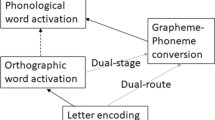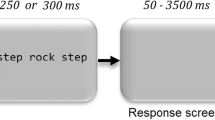Abstract
Reading is an expert visual and ocular motor function, learned mainly in a single orientation. Characterizing the features of this expertise can be accomplished by contrasts between reading of normal and inverted text, in which perceptual but not linguistic factors are altered. Our goal was to examine this inversion effect in healthy subjects reading text, to derive behavioral and ocular motor markers of perceptual expertise in reading, and to study these parameters before and after training with inverted reading. Seven subjects engaged in a 10-week program of 30 half-hour sessions of reading inverted text. Before and after training, we assessed reading of upright and inverted single words for response time and word-length effects, as well as reading of paragraphs for time required, accuracy, and ocular motor parameters. Before training, inverted reading was characterized by long reading times and large word-length effects, with eye movements showing more and longer fixations, more and smaller forward saccades, and more regressive saccades. Training partially reversed many of these effects in single word and text reading, with the best gains occurring in reading aloud time and proportion of regressive saccades and the least change in forward saccade amplitude. We conclude that reading speed and ocular motor parameters can serve as markers of perceptual expertise during reading and that training with inverted text over 10 weeks results in significant gains of reading expertise in this unfamiliar orientation. This approach may be useful in the rehabilitation of patients with hemianopic dyslexia.








Similar content being viewed by others
References
Aulhorn O (1948) Die lesegeschwindigkeit als funktion von buchstaben und zeilenlage. Pflugers Arch 250:12–25
Cohen NJ, Squire LR (1980) Preserved learning and retention of pattern-analyzing skill in amnesia: dissociation of knowing how and knowing that. Science 210:207–210
Coltheart M (1981) The MRC psycholinguistic database. Q J Exp Psychol 33:497–505
Frazier L, Rayner K (1982) Making and correcting errors during sentence comprehension: eye movements in the analysis of structurally ambiguous sentences. Cogn Psychol 14:178–210
Ishida T, Ikeda M (1989) Temporal properties of information extraction in reading studied by a text-mask replacement technique. J Opt Soc Am A 6:1624–1632
Kao CH, Chen DY, Chen CC (2010) The inversion effect in visual word form processing. Cortex 46:217–230
Kerkhoff G, Munssinger U, Haaf E, Eberle-Strauss G, Stogerer E (1992) Rehabilitation of homonymous scotomata in patients with postgeniculate damage of the visual system: saccadic compensation training. Restor Neurol Neurosci 4:245–254
Kolers PA (1968) The recognition of geometrically transformed text. Percept Psychophys 3:57–64
Kolers PA (1975) Memorial consequences of automatized encoding. J Exp Psychol 1:689–701
Kolers PA, Perkins DN (1975) Spatial and ordinal components of form perception and literacy. Cogn Psychol 7:228–267
Laubrock J, Kliegl R, Engbert R (2006) SWIFT explorations of age differences in eye movements during reading. Neurosci Biobehav Rev 30:872–884
Leff AP, Spitsyna G, Plant GT, Wise RJ (2006) Structural anatomy of pure and hemianopic alexia. J Neurol Neurosurg Psychiatry 77:1004–1007
Lefton LA, Nagle RJ, Johnson G, Fisher DF (1979) Eye movements dynamics of good and poor readers. Then and now. J Read Behav 11:319–328
Martelli M, Majaj NJ, Pelli DG (2005) Are faces processed like words? A diagnostic test for recognition by parts. J Vis 5:58–70
McDonald SA, Spitsyna G, Shillcock RC, Wise RJ, Leff AP (2006) Patients with hemianopic alexia adopt an inefficient eye movement strategy when reading text. Brain 129:158–167
Oldfield RC (1971) The assessment and analysis of handedness: the Edinburgh inventory. Neuropsychologia 9:97–113
Papageorgiou E, Hardiess G, Schaeffel F, Wiethoelter H, Karnath HO, Mallot H, Schoenfisch B, Schiefer U (2007) Assessment of vision-related quality of life in patients with homonymous visual field defects. Graefes Arch Clin Exp Ophthalmol 245:1749–1758
Parks TE (1983) Optical illusions in invertions. Perception 12:88
Pollatsek A, Bolozky S, Well AD, Rayner K (1981) Asymmetries in the perceptual span for Israeli readers. Brain Lang 14:174–180
Rayner K (1985) The role of eye movements in learning to read and reading disability. Remedial Spec Edu 6:53–60
Rayner K (1998) Eye movements in reading and information processing: 20 years of research. Psychol Bull 124:372–422
Rayner K, Duffy SA (1988) On-line comprehension processes and eye movements in reading. In: MacKinnon GE, Waller TG (eds) Reading research: advances in theory and practice. Academic Press, New York, pp 13–66
Rayner K, McConkie GW (1976) What guides a reader’s eye movements? Vision Res 16:829–837
Rayner K, Binder KS, Ashby J, Pollatsek A (2001) Eye movement control in reading: word predictability has little influence on initial landing positions in words. Vision Res 41:943–954
Reichle ED, Rayner K, Pollatsek A (2003) The E-Z reader model of eye-movement control in reading: comparisons to other models. Behav Brain Sci 26:445–476 (discussion 477–526)
Sankoh AJ, Huque MF, Dubey SD (1997) Some comments on frequently used multiple endpoint adjustments methods in clinical trials. Stat Med 16:2529–2542
Schuett S, Heywood CA, Kentridge RW, Zihl J (2008a) Rehabilitation of hemianopic dyslexia: are words necessary for re-learning oculomotor control? Brain 131:3156–3168
Schuett S, Heywood CA, Kentridge RW, Zihl J (2008b) The significance of visual information processing in reading: insights from hemianopic dyslexia. Neuropsychologia 46:2445–2462
Sheldon CA, Abegg M, Sekunova A, Barton JJS (2012) The word-length effect in acquired alexia, and real and virtual hemianopia. Neuropsychologia 50:841–851
Spitzyna GA, Wise RJ, McDonald SA, Plant GT, Kidd D, Crewes H, Leff AP (2007) Optokinetic therapy improves text reading in patients with hemianopic alexia: a controlled trial. Neurology 68:1922–1930
Taylor SE (1965) Eye movements while reading: facts and fallacies. Am Edu Res J 2:187–202
Thompson P (1980) Margaret Thatcher: a new illusion. Perception 9:483–484
Trauzettel-Klosinski S, Dietz K (2012) Standardized assessment of reading performance: the New International Reading Speed Texts IReST. Invest Ophthalmol Vis Sci 53:5452–5461
Valentine T (1988) Upside-down Faces: a review of the effect of inversion upon face recognition. Br J Psychol 79:471–491
Yin RK (1969) Looking at upside-down faces. J Exp Psychol 81:141
Acknowledgments
JB was supported by a Canada Research Chair and the Marianne Koerner Chair in Brain Diseases. Jayalakshmi Viswanathan assisted with programming the experiment. We thank Laura Eklinder Björnström for helpful discussions.
Author information
Authors and Affiliations
Corresponding author
Rights and permissions
About this article
Cite this article
Ahlén, E., Hills, C.S., Hanif, H.M. et al. Learning to read upside-down: a study of perceptual expertise and its acquisition. Exp Brain Res 232, 1025–1036 (2014). https://doi.org/10.1007/s00221-013-3813-9
Received:
Accepted:
Published:
Issue Date:
DOI: https://doi.org/10.1007/s00221-013-3813-9




